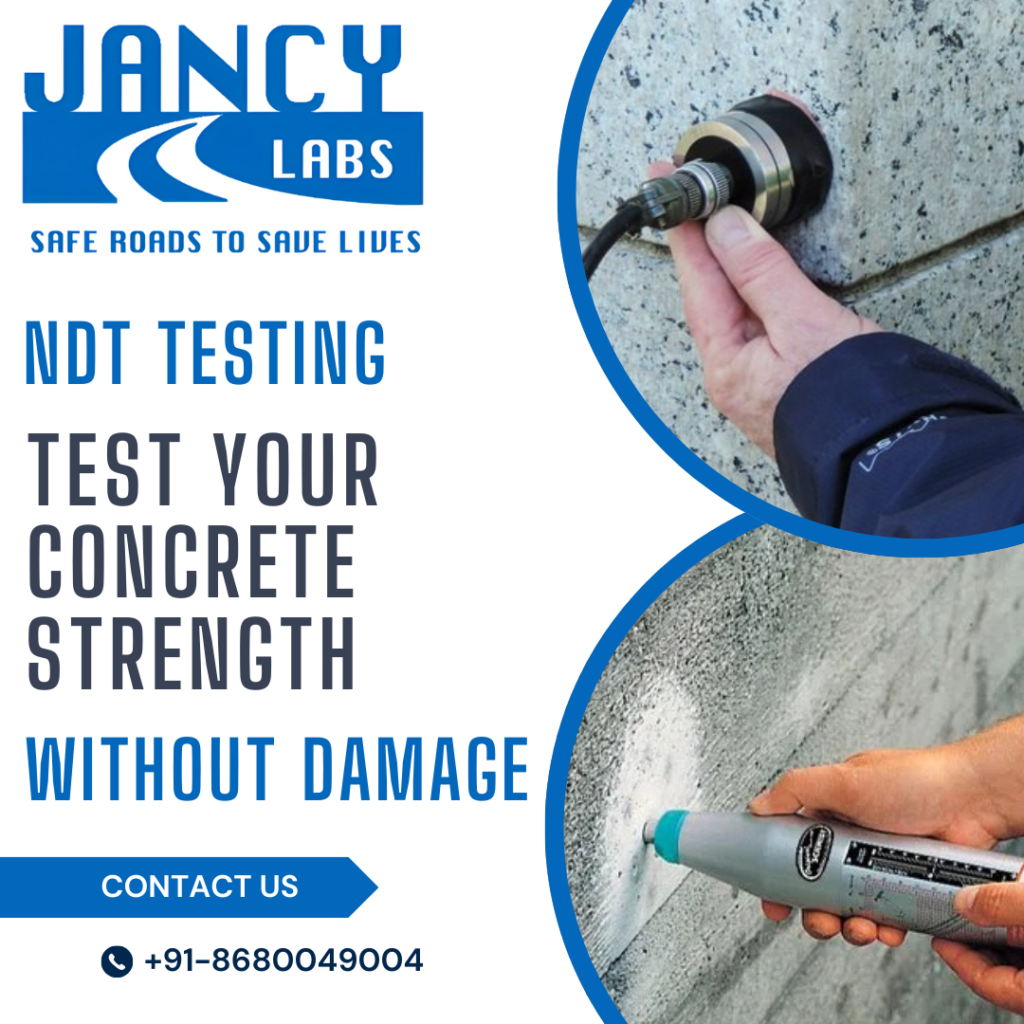
Non-Destructive Testing (NDT) and Destructive Testing (DT):
Choosing the right testing method is crucial for the safety, quality, and longevity of any construction project. You must decide between NDT and DT, both of which serve different yet essential roles in material evaluation. At Jancy Labs, we help you understand these methods so you can make the most informed decision for your specific project.
What Is Non-Destructive Testing (NDT)?
Non-Destructive Testing is a method used to assess material quality without causing any physical damage. Since the structure or component remains intact, you can use it even after the testing process. This method is ideal when you want to monitor strength without compromising usability.
At Jancy Labs, we focus on two highly effective NDT techniques: the Ultrasonic Pulse Velocity (UPV) Test and the Rebound Hammer Test. These tests offer quick, cost-effective insights into the condition of concrete and other structural materials. You can rely on these methods for regular maintenance, quality checks, and structural health monitoring.
Understanding the Rebound Hammer Test
The Rebound Hammer Test is a simple, fast, and non-invasive method used to estimate the surface compressive strength of concrete. In this test, a spring-driven hammer impacts the surface, and the rebound distance is recorded. The greater the rebound, the harder the surface.
Because the hammer does not damage the concrete, this method is perfect for on-site evaluations. You can use it to compare strength across different areas of a structure, or to quickly check the consistency of construction work. At Jancy Labs, we use calibrated rebound hammers to deliver accurate and repeatable results, helping you make confident decisions on the go.
Exploring the Ultrasonic Pulse Velocity (UPV) Test
The Ultrasonic Pulse Velocity Test evaluates the internal quality and uniformity of concrete by sending high-frequency sound waves through the material. The speed at which these waves travel reveals potential cracks, voids, or honeycombing inside the structure.
You can benefit from this method when you need deeper insight into internal integrity without cutting or coring. Since UPV detects flaws invisible to the naked eye, it provides valuable data for both new and existing structures. At Jancy Labs, we perform UPV testing with advanced digital equipment to ensure high reliability and fast turnaround.
What Is Destructive Testing?
Destructive Testing involves applying stress or force to a material until it fails. This method provides exact data on material strength, load-bearing capacity, elasticity, and durability. Although the test specimen is permanently damaged, it offers insight into how the material behaves under real-world stress conditions.
At Jancy Labs, we carry out destructive tests such as compression, flexural, and tensile strength tests, following all relevant BIS and ISO standards. You can use destructive testing during product development, supplier validation, or compliance checks when a detailed analysis of material behavior is necessary.
Key Differences Between NDT and Destructive Testing
Although both methods evaluate material performance, their approaches differ significantly. You can choose NDT when the structure must remain intact after testing, while DT is better when you can afford to destroy a sample to gather in-depth mechanical data.
NDT gives you quick insights and keeps materials in service, whereas DT delivers deeper understanding of failure points. At Jancy Labs, we help clients choose the most suitable method based on project stage, testing purpose, and material type.
When Should You Choose NDT?
You should use NDT when testing live structures, such as bridges, buildings, or roads already in use. Since NDT methods like the rebound hammer and UPV test do not alter or destroy the material, you can keep using the structure immediately after inspection.
For ongoing maintenance schedules, you will find NDT to be more economical and efficient. At Jancy Labs, we recommend NDT when you need fast evaluations, especially for early-stage construction audits and health monitoring of aging infrastructure.
When Does Destructive Testing Become Essential?
Destructive Testing is essential when you must understand the true mechanical limits of your material. If you’re selecting a new supplier, designing a new mix, or preparing a critical structural element, you will need detailed destructive test reports.
This method helps ensure compliance with national standards and verifies whether materials meet safety thresholds. At Jancy Labs, we conduct DT with extreme precision, giving you confidence in every measurement.
When Does Destructive Testing Become Essential?
The best testing method depends on several factors. If you aim to preserve the structure and need quick feedback, then NDT is your best choice. However, if your project requires comprehensive strength and performance data, you should choose Destructive Testing.
In many cases, combining both NDT and DT offers the most complete picture. At Jancy Labs, we tailor our testing solutions to your exact needs, ensuring you receive actionable insights without delays or unnecessary costs.
Why Choose Jancy Labs for Your Testing Needs?
At Jancy Labs, we bring years of experience in both Non-Destructive and Destructive Testing. As a NABL-accredited ISO 17025:2017 laboratory, we offer certified results trusted by builders, engineers, and government departments across the region.
We combine skilled technicians with state-of-the-art equipment to deliver fast, accurate, and compliant testing services. Whether you’re overseeing a highway project or building a residential complex, Jancy Labs supports your work with unmatched testing reliability.
Contact Information
Registered Office & Laboratory Address
Jancy labs Pvt Ltd,
No.6,Ganesh Nagar 3rd street, Surya Nagar, Alagar kovil main road, K.Pudur, Madurai-625007
Phone Numbers :
+91-8680049004 , +91-9994421275
Email : jancylabsmdu@gmail.com
Working Hours :
Monday to Saturday : 10:00 AM – 6:00 PM
